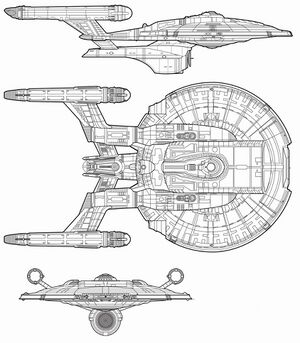Valourous-Class Frigate
History
Reconstruction and Refit
After the tremendous losses incurred by Starfleet during the Dominion War, the Federation was forced to begin a massive construction and reactivation program to refill the ranks of it's numerous Fleets, chiefly the decimated Second, Fifth and Seventh. This led to the establishment of the Triskelion Plan, a three pronged approach aimed at utilizing older mothballed hulls alongside indigenous and freshly produced ships as a stop-gap measure. This was due to the damage to both Earth and Sol's infrastructure during the attack by the Breen on Earth, which targeted both civilian housing on the planet and struck decisive blows at the ship cradles near Starbase 1 and the Utopia Plantia Ship Yards of Mars, which severely hampered efforts to replenish Starfleet.
While the damage at the Shipyards hindered attempts to build new vessels, they were of negligible importance for recommissioning vessels, as the primary components to replace could simply be brought to the ship with minimal modification to the external hull or support bulkheads. Furthermore, this enabled Starfleet to correct a lingering worry from before the war; that external forces might coopt their older vessels for use in deniable assaults. However, this plan had multiple detractors who argued against the utility and survivability of these vessels, as deficiencies in older class-patterns were considered likely to leave certain ships more vulnerable than a modern contemporary. The loss of the Joan D'Arc and Rich Heritage in separate attacks by Privateers seemed to bolster these arguments, as the more exposed EPS conduits of their original classes caused disastrous feedbacks in their Warp Cores.
In October of 2375 components of the Endeavor, Atlantis, Enterprise and the unfinished secondary hull of the prototype Reading Rainbow were gathered together in orbit of Starbase 1 to be assembled into a single vessel, using the partially reconstructed cradle "Charon" for the most complicated assembly operations. However, this cradle was only available for a few short weeks, negating plans to replace the EPS Conduits or Warp Core of the hull of the Reading Rainbow. The subsequent vessel was named the Porthos, as a means of honoring Jonathan Archer's beagle, the eponymous Porthos, by the Starfleet Corps of Engineers, with the original planned name for the vessel being replaced with it's then-unofficial designation in December. The ship itself launched early in 2376, thirteen months prior to the averted invasion of Earth by a small fleet of the Borg Collective.
That conflict would unfortunately serve as the last confrontation of the Porthos. Though it conducted itself with valor during it's maiden voyage, establishing first contact with four different species, and later being part of an extensive Anti-Piracy campaign alongside the Tchaikovsky and Excelsior, it was lost with all hands during the Battle of Earth. It's distinctive service record, alongside the enthusiastic wellspring of public support from the publishing of the After-Action Report, led Starfleet to declare that the construction of the class would continue beyond the projected end of the Triskelion plan. It was deemed, then, the Valourous-Class, as suited "the tireless courage of the crew of the Porthos, who did not waver from their commitment to the protection of other's lives".
Terran-Federation War Refit
In 2395, the F
Development
Several times during the Dominion War, forces aligned with -or at least sympathetic to- the Dominion took the opportunity to probe the defenses of dozens of key systems, as well as the fleets that protected them. These attacks came to be known as the Shen Krin-Tu, the Rising Wolves. By suddenly deploying from beyond sensor ranges, Dominion, Tholian, Gorn and
